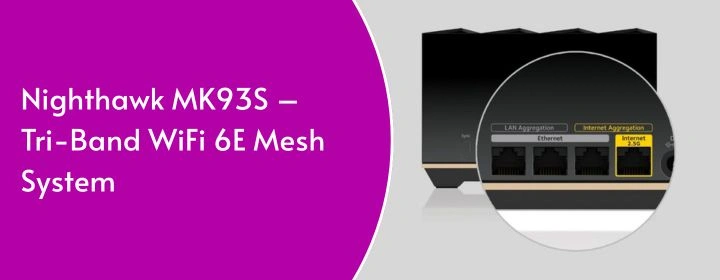Netgear Nighthawk MK93S is a tri band and mesh system with WiFi 6E technology. The setup is simple which we will going to explain in this post. We will start from unboxing the devices from the package & by describing the Netgear Nighthawk router connection we will end the setup by configuration.
After that, you should learn the troubleshooting tips to make the Nighthawk MK93S Mesh System setup error free.
Netgear MK93S Setup
Unbox Everything
You should have: 1 router (the one labeled “Router”), 2 satellites, Power adapters for all 3, Ethernet cable. The router has a little sticker on it with the default SSID and password. Don’t peel it off. You’ll need that.
Turn off Your Old Network (if you have one)
If you’re replacing an old router, unplug that thing. Modem stays plugged in — we still need the internet, obviously — but ditch any other routers or access points for now. Keep it simple.
Also, if you’ve got a combo modem/router, you might want to put it in bridge mode. Depends on how fancy you want to get. We skipped that for day one and it still worked.
Plug in the Router First
- The LAN or Ethernet cable goes from your modem to the yellow port on the router.
- Now, power on the device, wait for the white LED to stop blinking and go solid. It’ll take a minute or two.
Mine did this thing where it blinked for like 3 minutes. Thought it was bricked. It wasn’t. Just let it do its thing.
Download the Nighthawk App
It actually works decently for this Netgear MK93S setup.
- First, you should Download the Nighthawk app from the App Store or Google Play.
- Open it, make an account or sign in if you already have one.
- Tap “Set Up a New System,” pick “Mesh WiFi System,” then select the MK93 or whatever looks close enough.
It’ll walk you through the steps. Just follow along — it’s not rocket science.
Let the App Detect the Router
- Make sure your phone is connected to the default network (SSID from the sticker).
- Try restarting the app.
- Curse under your breath. Then try again.
Once it finds the router, you’ll rename your Wi-Fi and set a new password. Pro tip: don’t get cute with the name. Just something easy to recognize.
Plug in the Satellites
Now the fun part — place the satellites where you want better coverage. Upstairs, office, whatever. Plug them in. They’ll blink white, then go solid white when they’re connected.
If they’re blinking for like 10 minutes? Move them closer to the router. These things talk over Wi-Fi backhaul unless you wire them with Ethernet.
App Will Show You the Status
Give it a minute. The app will update and show all your devices — router and satellites — with a little green “Good” label if everything’s working.
You can tap into each one and check signal strength, run a speed test, whatever.
Troubleshooting Tips: Netgear MK93S Setup
Power Cycle Everything
Before you dive into the settings abyss, unplug everything — modem, main router, satellites. Wait 30 seconds. Plug in the modem first, then the main mesh node, then the satellites. Wait after each step until you get solid lights. This fixes more issues than you’d think.
App Not Finding the Router
Yeah, the app can be finicky. Make sure you’re on 2.4GHz, not 5GHz or mobile data. Some phones (looking at you, iPhones) switch networks mid-setup. Lock it to 2.4GHz if you can, or just do setup from a laptop using the web interface.
Also: disable any VPNs or battery saver modes. They mess with discovery.
Satellites Won’t Sync?
- Place them closer. Like stupidly close. Start with them in the same room.
- Wait longer than feels reasonable — like, 3–5 minutes per node.
- If the LED is blinking weirdly (red or blue flashes), do a factory reset on that node: hold the reset pinhole 10–15 seconds. Try again.
Still no luck? Use Ethernet to link them temporarily. That usually forces a sync.
Can’t Access the Web Interface?
Default IP is usually 192.168.1.1 or 192.168.0.1. Try both. If that fails:
- Open Command Prompt (Windows) or Terminal (macOS)
- Run ipconfig (Win) or ifconfig (Mac)
- Look for the “Default Gateway” — that’s your router’s IP
Punch that into your browser. Should work.
Internet Works, But Mesh Feels Sluggish
- Go into QoS settings and turn that crap off unless you’re actually shaping traffic
- Make sure firmware is up to date — you’d be surprised how many stability fixes hide in those boring updates
- Try switching DNS to Cloudflare (1.1.1.1) or Google (8.8.8.8). ISPs DNS is hot garbage sometimes.

